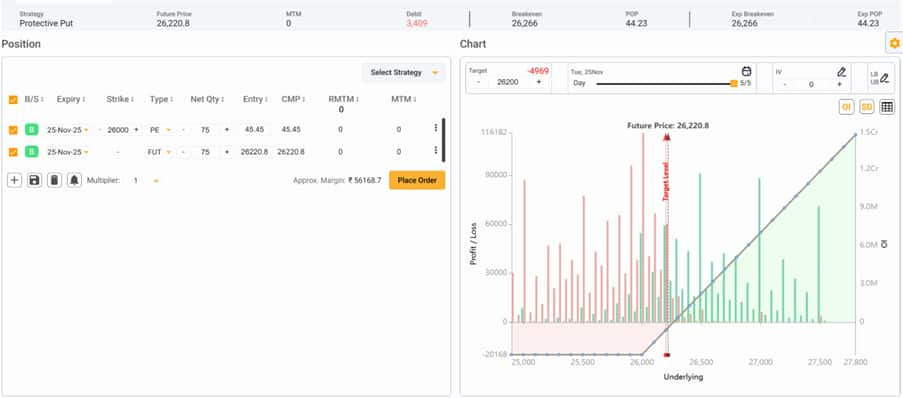Option, an instrument for every market mood swing: Shubham Agarwal
When we know the indices are behaving in a way where shocks are taken very seriously and immediate impact is lethal, it makes sense to invest in a lower strike Put Buy on the first sign of weakness.
SHUBHAM AGARWAL | 17-Oct-20
Reading Time: 3 minutes

A lot has been talked about the flexibility that options have in translating the peculiarity of the view into the expected pay-off from the trade. Recent moves could not have been more apt to discuss and leverage on some of those characteristics of options.
The recent moves, especially since we have been trading above the level of 11,000, have had a rather painful characteristic. Though the gains almost to 12,000 did manage to bring cheer, the slow and gyrating moves upwards with rather less frequent yet persistent‘ fierce drops’ have become a common characteristic.
Let us take the example of the current market situation with a combination of such slower rise and deeper cuts in a rising market to understand the agility that options provide and establish the fact that such market moods can be tackled with options efficiently.
First of all, let us take the challenge of slower moves.While many of us get intrigued by the economic nature of the single option and the profit potential, we have also over a period of time learnt to appreciate the perishable nature of the option premium.
Now, one may argue that when we know the market is going to be slow, why waste money by investing into inefficient time - value of options ? Valid point, but remember, we are also faced with rather lethal falls in the market, which come unannounced right after a hunky - dory session.
Hence, resorting to options is wise.The only change that we need to make here is, the Option Bought has to be immune, if not fully, at least partially to the time - value decay.To safeguard from the same, we can simply convert this single option into a spread.This can be done by selling Call option of a strike at least two - three steps higher than the one that is bought.
While this is simple, it may still not be good enough in case we have a bit medium - term view.In that case, one may resort to Modified Call Butterfly . Here, one creates the same spread but instead of selling one, sells two options of the higher strike.Along with that, buy a Call of a strike slightly higher than that.By slightly, we mean the difference between the lowest Strike bought and two strikes sold should be higher than the sold Strike and the higher Strike bought.
What this will do is, it will give is an economical way of trading a 10 - 15 days move with limited outflow, where the price objective is set in a zone(closer to the sold Strike).Now the traditional Butterfly would lose money for you if the stock rockets up, but the Modified Butterfly will give constant profit in case if the stock ends up above the Bought strike on the top. 
These are some of the ways and means of managing the slower moves at the same time accounting for an accidental drop.On the other hand, when we know the indices are behaving such, where the shocks are taken very seriously and immediate impact is lethal, it makes sense to invest in a lower strike Put Buy on the first sign of weakness.
It may not be the only thing traded and may not even be held from more than one or two days if it is not making money.However, if the sudden drop turns into the one that we witnessed on the September 2020 expiry week;it could actually turn out to be a super profitable trade.
Finally, as we all know trading is a reactive science, hence it is always advisable to adjust the choice of strategies based on the current market mood.
(The author is CEO & Head of Research at Quantsapp)
Disclaimer: The views and investment tips expressed by experts on Moneycontrol.com are their own and not that of the website or its management.Moneycontrol.com advises users to check with certified experts before taking any investment decisions.
Learn and read more about What are derivatives from Quantsapp classroom which has been curated for understanding of futures contract from scratch, to enable option traders grasp the concepts practically and apply them in a data-driven trading approach.
Recent Articles

Best trending option trading strategies: Shubham Agarwal
29-Nov-25

3 best ways to hedge using Options: Shubham Agarwal!
22-Nov-25

When in doubt to write, do Iron Fly: Shubham Agarwal!
15-Nov-25

Identify potential turning points with advance-decline: Shubham Agarwal
08-Nov-25

Slow and spreads more efficient: Shubham Agarwal
01-Nov-25

Use implied volatility as probable top finder: Shubham Agarwal
25-Oct-25

How to trade potential breakout post consolidation: Shubham Agarwal!
18-Oct-25

Use Options OI for intraday trading: Shubham Agarwal
11-Oct-25

SHUBHAM AGARWAL is a CEO & Head of Research at Quantsapp Pvt. Ltd. He has been into many major kinds of market research and has been a programmer himself in Tens of programming languages. Earlier to the current position, Shubham has served for Motilal Oswal as Head of Quantitative, Technical & Derivatives Research and as a Technical Analyst at JM Financial.
Recent Articles

Best trending option trading strategies: Shubham Agarwal
29-Nov-25 09:32:00

3 best ways to hedge using Options: Shubham Agarwal!
22-Nov-25 09:11:00

When in doubt to write, do Iron Fly: Shubham Agarwal!
15-Nov-25 10:48:00

Identify potential turning points with advance-decline: Shubham Agarwal
08-Nov-25 10:35:00

Slow and spreads more efficient: Shubham Agarwal
01-Nov-25 10:35:00

Use implied volatility as probable top finder: Shubham Agarwal
25-Oct-25 09:56:00

How to trade potential breakout post consolidation: Shubham Agarwal!
18-Oct-25 09:20:00











